Welcome to fall semester
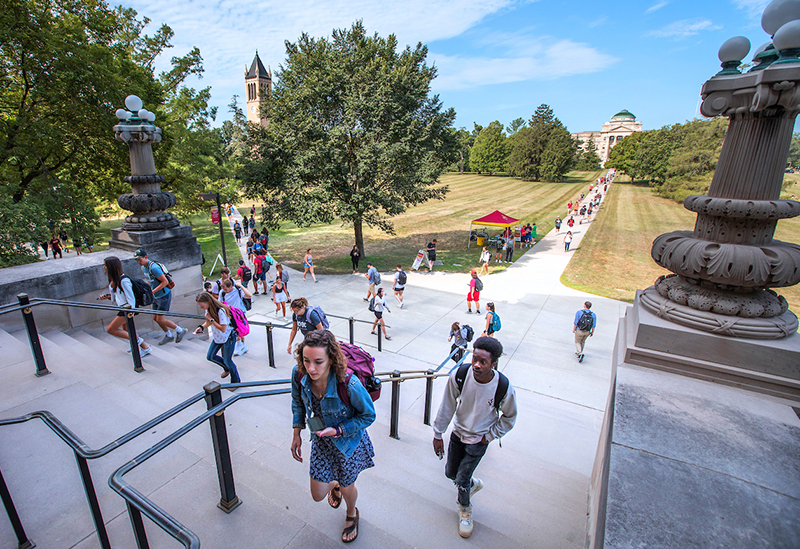
Students climb the west steps of Curtiss Hall on a warm Monday morning, the first day of fall semester. Photo by Christopher Gannon.
Alumni and friends make lasting impact through 'Forever True, For Iowa State' campaign
Madisyn Rostro knows the impact of the $1.542 billion that alumni and friends of Iowa State University gave through the "Forever True, For Iowa State" campaign. With the help of a scholarship and an internship made possible because of donor support, the senior history major was able to achieve her goal of being the first in her family to attend college and gain experience for her future career. Her story is one example of how students are benefiting from the generosity of donors, whose giving exceeded the campaign's goal of raising $1.5 billion.
Every aspect of Iowa State -- from faculty, staff and programs to facilities such as the Student Innovation Center and the Veterinary Diagnostic Lab -- is benefiting from donor generosity, which is helping advance Iowa State by providing support today and for generations to come.
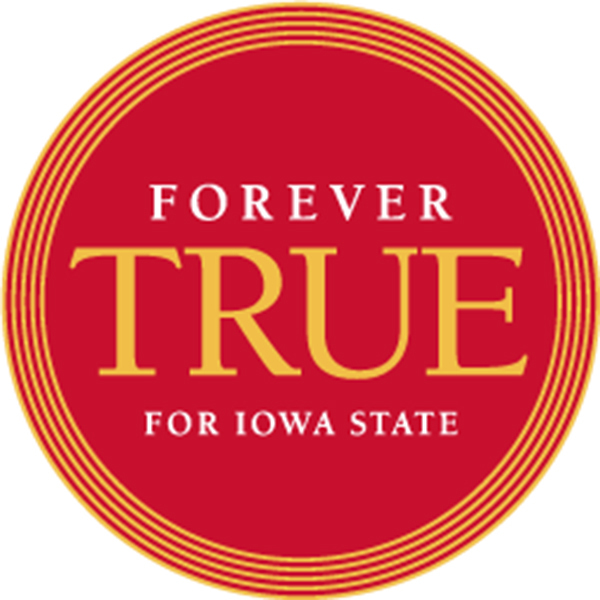
"The historic success of the campaign is a testament to Iowa State University's powerful impact -- providing access to an excellent education, conducting innovative and impactful research, and ensuring science-based resources and programs are widely available through extension and outreach," said President Wendy Wintersteen. "We are deeply grateful for the generous investments made by tens of thousands of individuals, businesses and organizations who recognize Iowa State's unique value to the state, nation and world."
At the campaign close on June 30, 2021, more than 96,000 donors made 532,377 gifts and commitments during the campaign's nine-year duration.
- 35,508 are first-time donors to Iowa State
- 3,828 are businesses or organizations
- 58,231 are Iowa State University alumni
- Donors are from all 50 states and 49 countries
In addition, hundreds of volunteers gave their time and talent to help advance the university through the campaign.
"The campaign's extraordinary achievement directly shows the generosity of Iowans and people from across the world and the dedication they have to Iowa State, especially during challenging times," said Jon Fleming, a 1975 Iowa State graduate who served as the "Forever True, For Iowa State" campaign chair.
The support from Iowa State donors exceeded the campaign's goal twice. In 2019, the campaign reached its initial goal of $1.1 billion two years ahead of schedule. Donors stepped up to the challenge of an increased target of $1.5 billion by June 30, 2021, to help meet the needs at Iowa State.
This includes helping ensure students have access to Iowa State's exceptional education offering practical, global and leadership experiences.
Through the campaign, donors gave $500 million for student support, which facilitates access to an Iowa State education and increases the ability to attract students from across Iowa and the world. Donor support enables students to engage in an exceptional Iowa State experience, from student organizations and study abroad to undergraduate research and internships that help prepare them for the workforce. For example, more than 56,000 donor-funded scholarships have been awarded to students during the campaign.
This support is helping students today and will continue to be available far into the future, providing generations of students access to an Iowa State education.
Some examples of student support include:
- The newly established Bergstrom Achievement Scholarship Program, which will help ensure students from a range of backgrounds have access to higher education in the Debbie and Jerry Ivy College of Business.
- The Transforming Liberal Arts and Sciences Fund (Transforming LAS), which has enabled the college to triple the funds available for scholarships and student awards, as well as enhance programs and faculty support.
- The College of Engineering's Builder's Association Scholarships, which encourage students to pursue careers in construction engineering or related fields.
- Completion, success and other grants that help students meet financial needs while in school to achieve their education goals.
- Confluence, Inc. Landscape Architecture Studio Prize, which recognizes outstanding student work in landscape architecture.
- The Eliminating Barriers for Future Farmers Scholarship, which assists students interested in production agriculture.
Donor support is also enabling Iowa State's outstanding faculty and staff to provide a top-level education and inspire a spirit of innovation in students as they uplift Iowa State as a global leader in the quest for solutions to issues such as food and water insecurity, human and animal health, cybersecurity, sustainability and many other critical areas. Examples include:
- One Health Initiative
- Iowa State Hazard Mitigation and Community Resilience Program in the College of Engineering
- Alice Hudson Professorship in Chemistry in the College of Liberal Arts and Sciences
- Kingland Professorship of Data Science
- Graether Family Fund for Climate Science Advancement
Because of donors, 148 new funds were established during the campaign to support faculty positions, which include fellowships, professorships, department chairs and deanships.
Advanced and vibrant facilities are a keystone in carrying out the collaborative and hands-on education, cutting-edge research and outreach at the university. Donors gave more than $275 million in gifts and commitments to fully or partially fund new or revitalized facilities, including research laboratories, classrooms, collaboration spaces and more. Examples include:
- Student Innovation Center
- Nanovaccine Institute
- Gerdin Building Expansion
- Veterinary Diagnostic Laboratory
- Robert T. Hamilton Poultry Teaching and Research Farm
- Parks Library Digital Scholarship Laboratory
- LeBaron/MacKay Complex
- Stark Performance Center
More information and stories about the lasting impact donors have made through the "Forever True, For Iowa State" campaign are at ForeverTrueISU.com.
COVID-19 sick leave continues, flexibility offered to immunocompromised
Employees will have up to two extra weeks of sick leave to use over the next year for absences related to COVID-19, and faculty and staff who have specific conditions that lower immunity levels may have an option to work remotely during the fall semester, under two new programs university human resources (UHR) announced late last week.
Separate sick time for COVID-19
As they did during a nine-month period in 2020 and again from Jan. 1 until June 30, ISU employees will have access to 80 hours of paid sick leave for COVID-19 absences, a temporary bank of time available throughout the fiscal year ending June 30, 2022, vice president for UHR Kristi Darr announced in an Aug. 20 message to faculty and staff. The sick leave bank will be prorated for part-time employees. Students, temporary and seasonal employees will have up to 20 hours.
The state Board of Regents approved the additional bank of sick leave, which is available as an absence option in Workday as "BOR COVID-19 Sick Time Off Plan." The time off can be used by employees diagnosed with COVID-19 or quarantining due to exposure, as directed by a health care provider. Employees also can access COVID-19 leave if they are caring for an immediate family member with COVID-19 or a child whose school or child care provider has closed due to COVID-19.
Documentation may be required to support using the COVID-19 time off plan.
Options for immunocompromised
Faculty and staff who have a compromised immune system due to a specific set of medical conditions may be allowed to modify their job responsibilities to work remotely, under an option approved by the state Board of Regents, Darr said in the memo. This includes instructors, who would be allowed to change their course modality from in-person to online. The option also may be available to faculty and staff who live with an immunocompromised person.
Qualifying as immunocompromised under this provision in place for the fall 2021 semester will require meeting the same standards as those the Centers for Disease Control and Prevention established for being currently eligible for a third booster shot of the Pfizer or Moderna COVID-19 vaccines:
- Receiving active cancer treatment for tumors or cancers of the blood
- Received an organ transplant and are taking medicine to suppress the immune system
- Received a stem cell transplant within the last two years or are taking medicine to suppress the immune system
- Moderate or severe primary immunodeficiency (such as DiGeorge syndrome or Wiskott-Aldrich syndrome)
- Advanced or untreated HIV infection
- Active treatment with high-dose corticosteroids or other drugs that may suppress immune response
Individuals who seek a workplace modification due to concerns about reduced immune response will need to provide medical documentation to UHR and receive approval from the appropriate senior leader in their college or division.
Immunocompromised faculty and staff also may be eligible for accommodations under the Americans with Disabilities Act, paid time off from the COVID-19 sick leave plan and usual time off accruals, or leave through the Family Medical Leave Act. Contact UHR with any questions by email at uhrdar@iastate.edu.
Degree completion outreach may become ongoing effort
Callie Morrow can empathize with ISU students who left school without graduating. She took a couple years off from Iowa State after getting married her sophomore year and had trepidations about whether she'd get a chance to come back and finish.
"When you do, often your life is very different," said Morrow, senior academic advisor for the online learning program jointly run by the Engineering and Liberal Arts and Sciences colleges.
Like Morrow did, returning students may have parenting obligations the second time around. Or a full-time job. Or be living across the country. One way or another, there's usually juggling.
"A lot of the advising conversations are about how you balance your life and still get your degree," she said.
Those conversations have been more common in recent years, as Morrow's been involved in two initiatives designed to urge former students to complete degrees they are close to earning. Outreach in 2017 and 2018 targeted former LAS students and was followed by a 2020 effort to reach out to near-graduates from all the undergraduate colleges.
The broader push -- led by the provost's office and spurred by participation in an Institute for Higher Education Policy initiative called Degrees When Due -- likely will become a recurring campaign, with new lists of potential returners pulled every couple years, said Shawn Boyne, director of academic quality and undergraduate education.
"As a land-grant institution it's part of our mission to do everything we can to help students get across the finish line and graduate," she said.
Personal impact
As part of the 2020 campaign, nine students have been awarded diplomas and four others are on track to graduate. That's after first identifying 507 students who left Iowa State three to five years earlier who were within 30 credits of graduating. Boyne and Morrow said though the proportion of potential completers successfully nudged is small, the impact on their lives is enormous.
"Even if it was just one, it would be worth it," Morrow said.
It took an ongoing team brainstorming effort to troubleshoot data issues and to identify and find students, involving a circle of folks from the registrar’s office, institutional research and LAS. Jane Jacobson, who retired as the LAS director of student enrollment, advising and career services in 2019, joined the project as a temporary employee to run initial degree audits on the overall list. Morrow worked directly with interested former students, collaborating with their prior advisors to consider specific options. A few students were able to graduate in their original program, while others found that it would be simpler to pursue a bachelor of liberal studies, an online-based degree program LAS offers. Sometimes a different year's catalog fit better with a student's transcript. Finding the most efficient path to graduation was like putting together a puzzle, Morrow said.
"It's important work, but it's labor-intensive work," Boyne said.
Assistance available
Twelve of the departed students identified in the initial sweep already had fulfilled the graduation requirements. But largely due to problems tracking down accurate contact information, only four of those students have been awarded the degrees they've earned. Even with the help of the ISU Foundation and social media, finding former students is a challenge, Morrow said.
Different messages were crafted for students based on the amount of coursework remaining, and 130 students who were the closest to a diploma received a box of swag that included a specially designed coffee mug.
"It was just to say, 'You're a Cyclone,' and get people excited about Iowa State again," Morrow said.
For students who chose to enroll in courses aimed at finishing their degree, the provost's office funded a program to cover the tuition and fees in full for a student's first course and half the tuition and fees of any subsequent coursework. Those scholarships will remain available until the funding is gone, Boyne said.
The opportunity to finish their degree at a discount – for free, if a student was just one course short – was a thrilling surprise for students, Morrow said. But simply having someone encourage them to finish and outline how it can be done is powerful in its own right, she said.
"Every individual had a reason for leaving the institution. Maybe they're not ready to come back. But maybe they are, and they don't know their options," she said. "We get a lot of different kinds of reactions. But in the end, there is a lot of gratitude."
Johnson named associate VP for strategic relations and communications
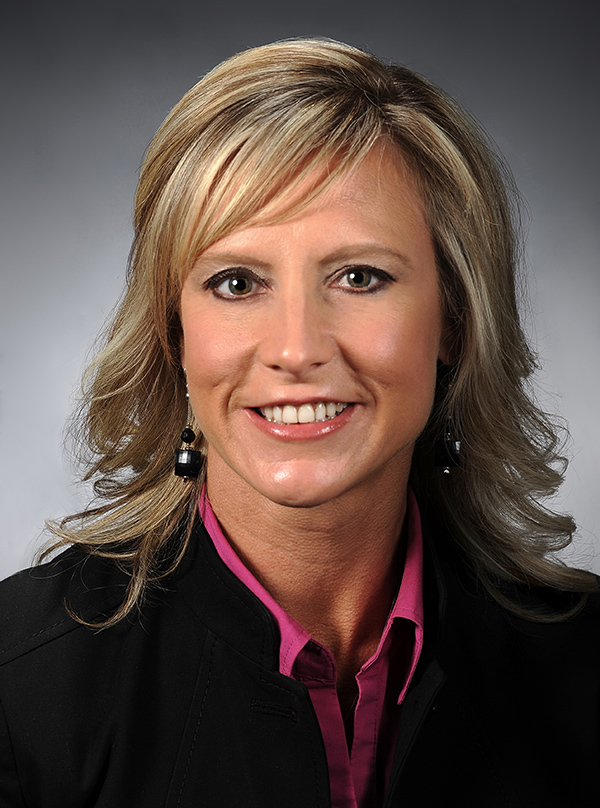
Jacy Johnson
Jacy Johnson has been named the inaugural associate vice president for strategic relations and communications, following a national search. The appointment is effective Sept. 1.
Johnson has served as interim associate vice president of the office of strategic relations and communications since July 2019. She will provide leadership and strategy for university communications, marketing and public relations, and oversee the staff of the strategic relations and communications unit.
Johnson will report to President Wendy Wintersteen, who created the office of strategic relations and communications in 2019 to provide a strategic, integrated approach to institutional communications, public relations and marketing. The unit, which includes internal communications, news service, university marketing and photo services, replaced the office of university relations.
"For the past two years, Jacy has helped lead our first steps into this new strategic mindset, even as they were immediately put to the test in support of our response to a global health crisis," Wintersteen said. "I know that Jacy will continue these efforts to fulfill the vision and a new framework that will guide our universitywide communications and marketing efforts into the future."
Johnson has more than 25 years of experience in marketing and communications. She joined Iowa State in 2008, holding several leadership roles with ISU Extension and Outreach, including director of advancement. Before coming to ISU, she served as assistant vice president for marketing for Marsh McLennan in West Des Moines.
She earned an MBA, with a marketing emphasis, from Iowa State and a bachelor's degree in marketing and international business from the University of Northern Iowa.
Johnson's primary office is in the office of the president, 1750 Beardshear. She can be reached at 294-5672; email: jacyjohn@iastate.edu.
Faculty focus on student perspective in inclusive classroom training
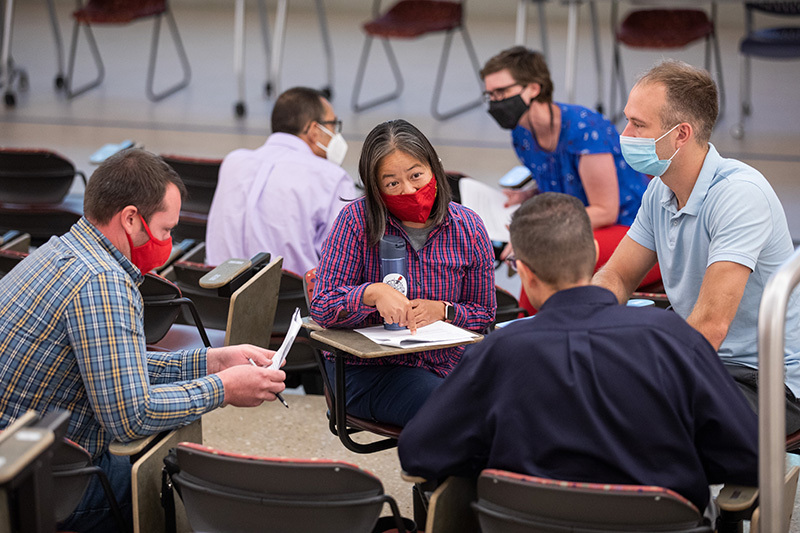
Faculty in the agricultural and biosystems engineering department worked in small groups during inclusive classroom training August 19. Photos by Christopher Gannon.
What did you feel the first time you walked into a classroom as a college student?
With that question, faculty members are transported into the shoes of their students, recalling the anxiety that comes with wanting to find your place in a new environment. The scenario sets the stage for the second year of inclusive classroom training, focused on creating a sense of belonging for Iowa State students.
The 2020 National Survey for Student Engagement asked 4,524 ISU freshmen and seniors if they felt part of the community and if they felt comfortable being themselves. Nineteen percent disagreed or strongly disagreed with the first question and 9% felt that way about the second question.
"Belonging contributes to our overall well-being with our physical, mental and emotional health," said Laura Bestler, Center for Excellence in Learning and Teaching (CELT) program specialist, during an Aug. 19 session with the agricultural and biosystems engineering (ABE) department. "Belonging is a necessary ingredient for our students' persistence in their major and retention at Iowa State."
One department at a time
Annual inclusive classroom training conducted by CELT staff is one of the 10 actions President Wendy Wintersteen identified in 2019 to address racism and discrimination on campus. The first year of training for all faculty began in January 2020 and focused on why teaching inclusively is important.
This year's training has three goals:
- Recognize how teaching plays an important role in a student's sense of belonging
- Identify strategies to create a student's sense of belonging in your teaching
- Locate student support services to use and share with them
Departments are able to customize the training to focus on topics and situations they are more likely to encounter.
Training will be completed this fall, with 51 departments having scheduled or completed it as of Aug. 24. Twelve have yet to schedule a session. Of those scheduled, 53% have chosen to conduct the training face-to-face and 47% through online synchronous instruction.
CELT will provide inclusive classroom training for graduate students during the spring semester.
Campus resources
A flipped learning approach is used, with faculty asked to complete readings, tasks and self-reflections in Canvas prior to training. This creates time during training to share experiences and expertise in small groups.
When students have issues inside or out of the classroom, a faculty member is a likely place they will turn, Bestler said.
"The training really helps me rehearse and set the scene in my head," said ABE associate professor Gretchen Mosher. "I am not having to make up a response on the spot. It provides me with the language to talk to a student because you don't always have time to overthink things."
Bestler said it's not solely on instructors to assist students in need, but being aware of available resources on campus can make the difference in students finding success. CELT has a webpage to guide faculty helping students in need with an emphasis on mental health.
"One out of three Iowa State students experiences significant mental health concerns, anxiety and relationship concerns," said Bestler.
ABE professor Brian Steward said the training is a good reminder to be empathetic to students, an expectation that is part of the department's culture.
Timely training
Bestler said because the last 18 months in a pandemic challenged everyone, the training is happening at an opportune time.
"Everyone knows how important it is for us to create that sense of belonging no matter where our students -- or we -- are right now," she said. "I truly believe people find this to be a valuable topic because we know how essential belonging is for our students to be successful."
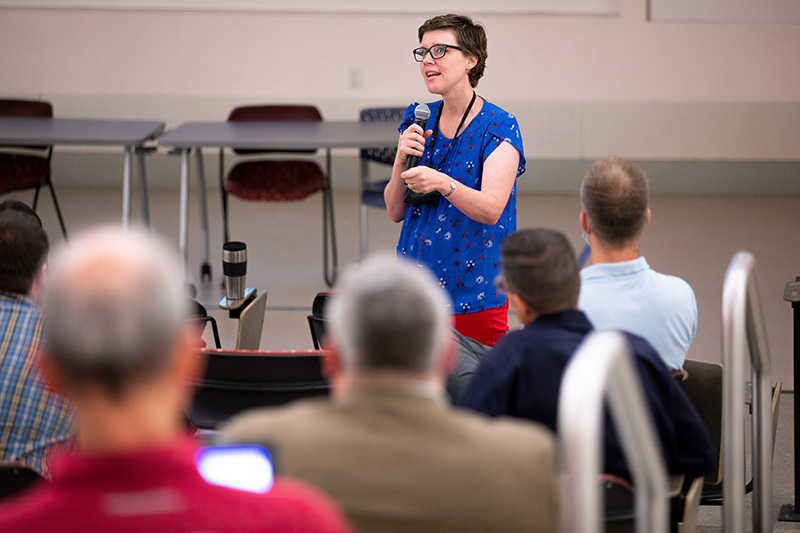
Agricultural and biosystems engineering interim chair Amy Kaleita shares some thoughts during inclusive classroom training.
A study room for the family
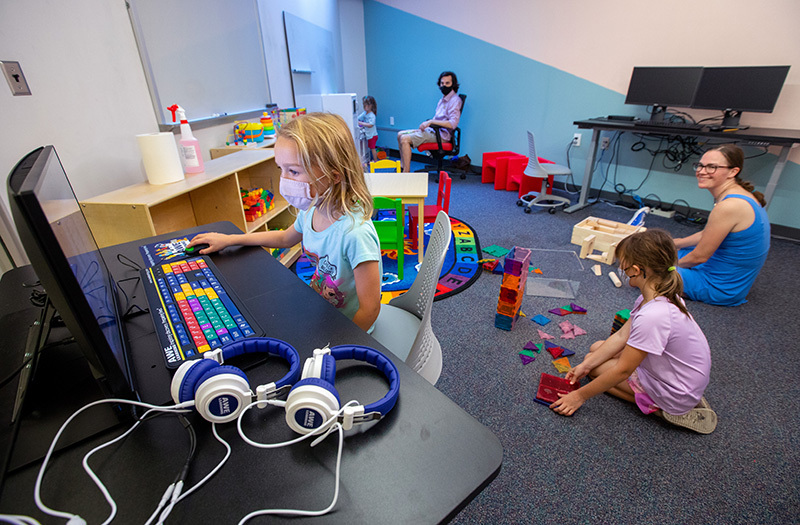
Ruby Schares, 7, uses a computer in Parks Library's family-friendly room Monday while her parents, Stephanie and Eric Schares (a Parks Library employee), look on with her siblings, Rose, 9, and June, 2. The family-friendly room, located on the lower level of the library, is a place anyone with a Net-ID who is a caregiver can bring children to learn and play while they study. The room can be reserved online. It's equipped with two adult workstations with universal docking stations, a black and white printer, whiteboards and markers. Photos by Christopher Gannon.
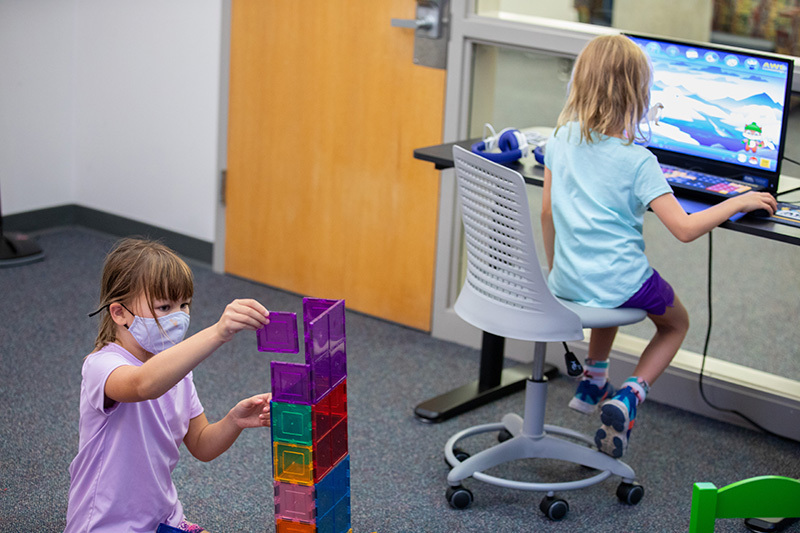
Rose Schares builds a tower in the Parks Library family-friendly room, which can be reserved online, while her sister, Ruby, plays on a computer. The room features child-sized furniture, toys and a computer for children with educational software.
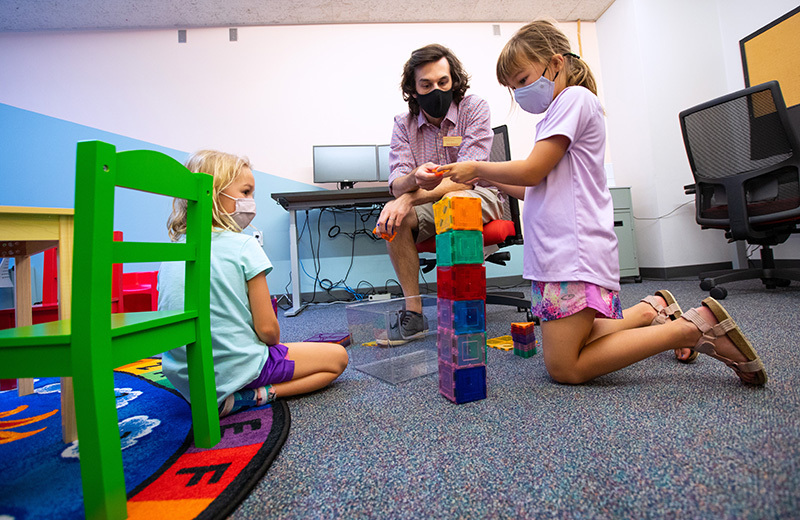
Eric Schares helps his daughters build a structure in Parks Library's family-friendly room. The room is large enough for two adults and up to six children. It's located near the children's book collection on Tier 1. It's also near family restrooms and a lactation room. The room can be reserved online.
Pollinator plots along Pammel tie in to larger network
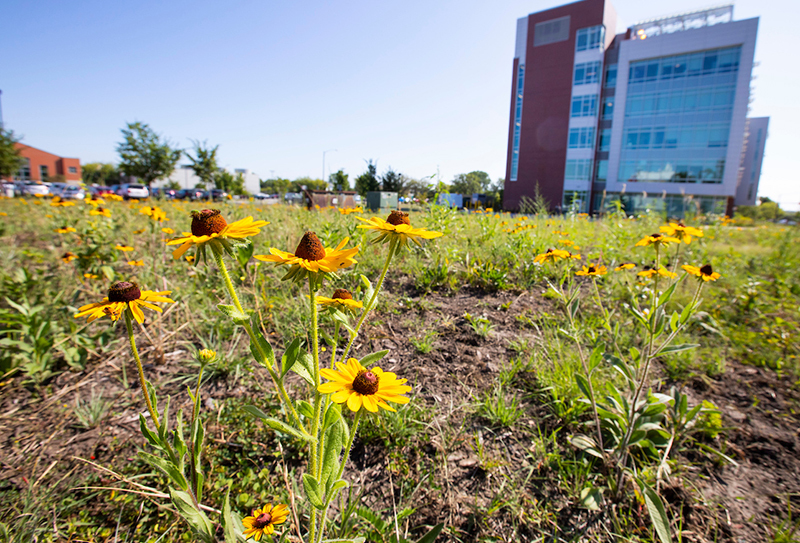
Pollinator habitat on the former Insectary building site had its second year of growth this summer. To the east is the Advanced Teaching and Research Building. Photo by Christopher Gannon.
Removing two aged buildings from the Pammel Drive corridor in the last 18 months presented an opportunity to do something different with their replacement green spaces. With help from a few campus partners, facilities planning and management's (FPM) design services team is seeding the former Insectary and Genetics Lab building sites with pollinator habitat, plots of about 20,000 square feet each.
The Insectary site was seeded in mid-December 2020 and again in late February 2021, and the Genetics Lab site, which FPM temporarily planted with oats this summer, will be seeded a couple of times this winter between the first snow and early March. The seeds need a few freeze and thaw cycles to break open, explained natural resource ecology management professor Steven Bradbury, one of several volunteer seeders on the project. In three to five years, about 50 species of Iowa-native plants, some up to 5 feet tall, will outlast the early weeds "for a really cool look," he said.
FPM landscape architect Joe Stoberl said the locations likely are future building sites. In the meantime, "this is an alternative way to green the space."
The intent is to provide a habitat for monarch butterflies as well as bees and other pollinators. Expanding monarchs' habitat plays a key role in their recovery as a species.
But Bradbury also said cost analysis research has shown establishing and maintaining a pollinator habitat is less costly than maintaining turf grass. And the sites present a teaching lab possibility in a few years, he added.
Small slice of a big picture
Bradbury is part of an interdisciplinary research and outreach group that supports the strategies of the Iowa Monarch Conservation Consortium, a 50-member partnership of universities, businesses, utilities, commodity groups and private groups and foundations. ISU and the state's Department of Natural Resources and Department of Agriculture and Land Stewardship are co-facilitators of the consortium, founded in 2015.
The idea to try something different on Pammel Drive bubbled up from multiple corners of campus, Stoberl said, including entomologist and university President Wendy Wintersteen, a co-founder of the consortium during her tenure as dean of the College of Agriculture and Life Sciences.
All pollinator plots contribute to the consortium's "big-picture" (20-year) strategy for monarch conservation in Iowa, Bradbury said. In turn, that state plan ties in to a broader mid-America plan involving states from the Dakotas to Ohio.
"If we can establish a sufficient number of habitat patches across the state, it will make a big difference," Bradbury said. "The monarch uses big and small sites, and they all help. Patches of this size, in rural and urban settings, are great."
Throughout her life a female monarch lays her eggs on milkweed plants, which are the only food source for monarch caterpillars.
Pollinator-friendly recipe
The research and outreach group created the recipe for the seed mix used on the two Pammel Drive plots. All 50 seeds in it are native to Iowa and available from commercial seed vendors. Bradbury said the mix is biased toward wildflowers (37 of the 50 species) to provide as many nectar sources as possible for monarchs and pollinators from early spring through September. The remaining seeds are prairie grasses. A more traditional prairie seed mix would feature a 1:1 ratio of wildflowers and grasses, he said.
The Pammel Drive sites are the monarch research and outreach team's first habitat on campus, but FPM has developed other pollinator gardens, Stoberl said, including the south sides of the National Laboratory for Agriculture and Environment and the College of Design and the west sides of Elm Hall and the Knoll.
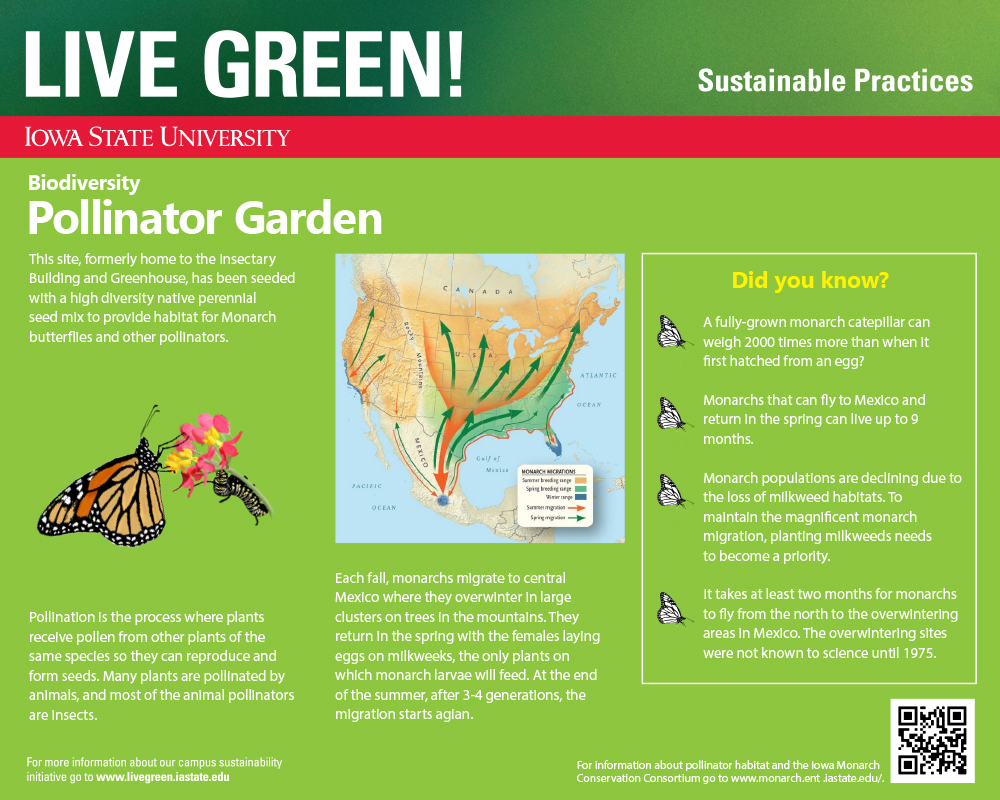
Facilities planning and management's educational sign on the west edge of the Insectary pollinator site.
Town hall focuses on strategies for a safe Cyclone community
A safe, healthy campus community and an educational experience that contains as many aspects as possible of a "normal" fall were the focus of the Aug. 19 town hall for faculty and staff. Guests Dan Fulton, infectious disease specialist with McFarland Clinic, and Les White, Story County public health director, joined ISU senior leaders to respond to questions about beginning the academic year while COVID-19 remains a threat in this country.
"Thank you for your continued efforts to make the semester a success," said President Wendy Wintersteen. "We deeply appreciate faculty and staff for their commitment and care for students and for each other."
Vaccines
Wintersteen -- and others -- reiterated the university's approach is to encourage every employee and student to be vaccinated. A series of free vaccination clinics on campus opened in mid-August and continues through at least the end of September. The Pfizer and Johnson & Johnson vaccines are available.
Associate vice president for student health and wellness Erin Baldwin said she anticipates approval within a month of a federal proposal to offer a third vaccine dose, and when that happens, employees would be able to receive that dose on campus. Immunocompromised employees and students, for whom a third dose is approved, are welcome to receive their third dose at any of the campus vaccination clinics, she said.
Cyclones Care 2.0
Four simple behaviors to protect your health and the well-being of the university community:
- Vaccinate
- Monitor your health
- Stay home if you're ill
- Wash your hands often
Fulton said vaccines are a little less effective against the delta variant of the COVID-19 virus. Efficacy will go up again with a third dose, though the medical community still doesn't know what the optimum vaccine series is for the longest-lasting immunity, he noted. Vaccines are the surest way to avoid serious illness.
The federal government's full approval -- not emergency use status -- of the available vaccines (which occurred since the town hall for the Pfizer vaccine) could not immediately change the university's policy on vaccination, said university counsel Michael Norton. The university also must heed state and state Board of Regents policies.
Norton said the university has no means to track the vaccination status of employees or students and can't require vaccination. County public health and the state department of public health have the most complete data, he said.
Masks
Baldwin said the Centers for Disease Control and Prevention's recommendation is to wear a face covering indoors, even if you're vaccinated. It adds a layer of protection and is another way to support the larger Cyclone community, she said.
The regents' policy also encourages mask wearing in indoor spaces in the presence of other people. Face masks are required in a few exceptions: CyRide buses, Thielen Student Health Center, College of Veterinary Medicine areas where face masks normally are required, and Ames Laboratory facilities.  Principal investigators or lab supervisors may set the mask rule for their own campus research laboratories.
Fulton said lots of data is available on masks as a mitigating strategy against infection. When worn correctly and consistently over time, masks can cut infection rates 66% to 70% by decreasing exposure. Even around others not wearing masks, they reduce exposure for their wearers, he said.
Leave options for employees
Wintersteen said the university received state Board of Regents approval for workplace modifications to protect immunocompromised employees or their household members who meet the definition set by the CDC. The regents also approved a second 80-hour bank of COVID-19 paid sick time off for the 2022 fiscal year (July 1, 2021-June 30, 2022). An Aug. 20 memo from vice president for university human resources Kristi Darr shared the details of these two additions.
Safe classrooms and offices
Wintersteen and senior vice president and provost Jonathan Wickert both thanked faculty and staff for their letters and petitions advocating for science-based COVID mitigation strategies. Wintersteen said she has received letters, too, from individuals who don't want to see vaccine or mask mandates on campus.
"We take these concerns seriously," she said. "The feedback is appreciated, and we are sharing these concerns and feedback with the regents."
In fact, the new employee leave options emerged from subsequent discussion among board staff members and Faculty Senate leaders.
Wickert said the goals for fall semester are to keep campus as safe as possible and provide a high-quality in-person learning experience while avoiding last year's double-teaching phenomenon (faculty teaching the same course online and in person). He encouraged faculty to have class discussions early on about topics like group work or pair work in class and attendance expectations. New this fall is that a student's positive COVID test result should be considered appropriate documentation for an excused absence, for which they can receive make-up materials.
He reminded faculty additional syllabus statements on vaccine, masking and physical distancing recommendations were prepared for the 2021-22 academic year. Faculty should encourage students to follow the measures and model the behavior they seek in their students.
In response to faculty concerns about keeping office hours in close quarters without a mask mandate, Wickert encouraged office hours "in 2019 mode." Virtual office hours may supplement but shouldn't replace in-person office hours, he said. Faculty also should consider other spaces for office hours, such as a conference room in their building or one of the college tents erected on campus to assist with academic continuity.
Positive COVID-19 tests
As of last week, White said the county was averaging 20 new COVID-19 cases a day, with 40% of current cases in 18- to 29-year-olds.
Anyone who tests positive for COVID-19, even if they don't show symptoms, should isolate for at least 10 days, Baldwin said.
Fulton said he expects a rise in COVID-19 cases in Iowa later this fall as people spend more time indoors, similar to a year ago. The difference this year, he noted, are the "incredibly effective" vaccines, which will mean fewer hospitalizations and deaths from the disease.
Resources
- Archived town hall recording
- COVID-19 Moving Forward website
- ISU public health slides (fall update)
- Submit your COVID-19 questions to COVID-19@iastate.edu
